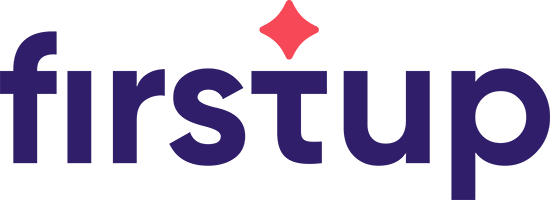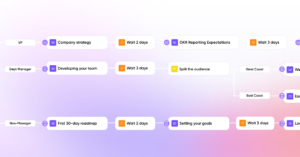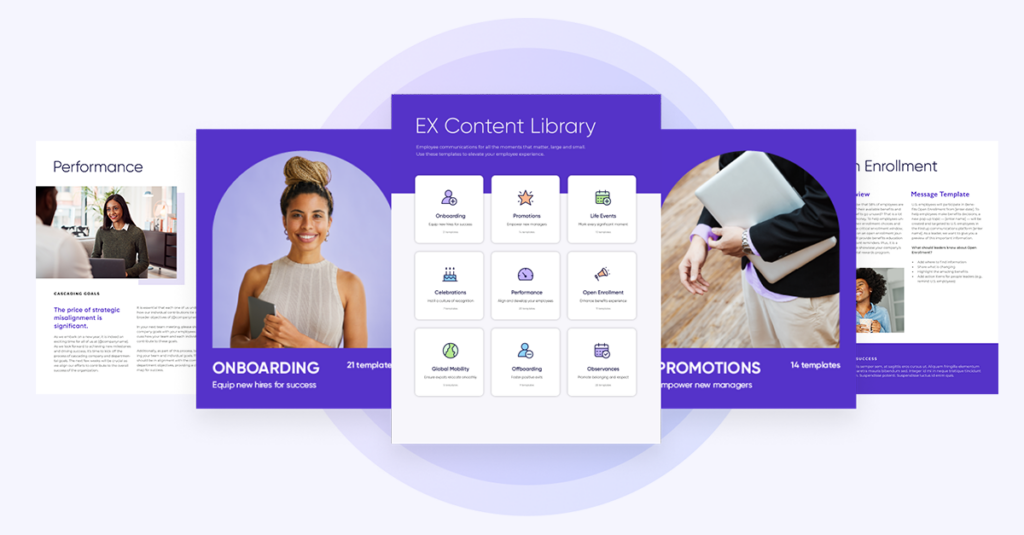Onboarding best practices are more than a checklist—they’re the foundation for creating a motivated and productive workforce. A seamless onboarding process not only integrates new hires into the organization but also drives retention, engagement, and long-term success. Companies that prioritize these best practices consistently achieve higher employee satisfaction and lower turnover, making onboarding a strategic priority in today’s competitive talent market.
Firstup simplifies onboarding by providing intelligent tools that ensure new team members have clear communication and easy access to critical resources from day one. With the right structure and personalized support, onboarding becomes a powerful driver of engagement, productivity, and organizational growth.
Deliver a hyper-personalized employee experience at scale
Laying the foundation for successful onboarding

Tip 1: structure the onboarding process for success
A well-structured user onboarding process is critical to ensure new hires transition smoothly into their roles. Start by creating a comprehensive onboarding checklist that outlines every step, from preboarding to the first 90 days. This checklist should cover essential tasks such as completing paperwork, accessing the employee handbook, and setting up tools.
Using a workforce communications platform can enhance this process by integrating automated workflows and tracking onboarding progress. Visual aids, such as employee journey maps, also help HR professionals and managers monitor each step and provide a seamless experience for each new hire. Research shows that companies with structured onboarding programs see up to a 82% increase in retention and a 70% boost in productivity
Tip 2: set new hires up for success with clear goals
Clear goals and expectations during onboarding are crucial for engaging and empowering every new hire. Managers should outline specific milestones for the first week, first month, and first 90 days. This approach reduces confusion and ensures alignment with organizational priorities.
Research from Gallup highlights that employees who feel their roles are well-defined are 2.5 times more likely to be engaged at work, contributing to a more motivated and productive workforce. Establishing these goals early ensures that new hires feel confident and supported, paving the way for long-term success.
Tip 3: measure the impact with key onboarding metrics
Tracking and analyzing onboarding metrics is essential for refining the process and ensuring long-term success. Key performance indicators include:
- Time-to-productivity
- Retention rates within the first year
- Feedback from each new hire on their onboarding experience
According to Gallup research, organizations that actively monitor and act on onboarding data achieve up to 23% higher profitability and 18% better retention. By prioritizing these metrics, HR teams can tailor onboarding strategies to meet employee needs and organizational goals effectively.
Personalizing and enhancing employee onboarding

Tip 4: create a memorable experience with an onboarding buddy program
An onboarding buddy program is a great way to provide immediate support and cultural insights to new hires. Buddies help new employees build rapport, navigate company processes, and adjust more quickly. Actionable steps for creating a buddy program include:
- Selecting experienced employees as buddies.
- Setting clear expectations for both buddies and new hires.
- Encouraging informal interactions, like coffee chats or virtual check-ins.
Onboarding buddy programs not only enhance the experience of onboarding, but also improve retention and engagement. By fostering early connections, new employees are more likely to feel a part of the company’s culture.
Tip 5: personalize onboarding for greater impact
Every new hire is unique, so personalizing the onboarding process can significantly enhance their experience. Personalized onboarding includes tailoring training materials, role-specific workflows, and communication styles to each individual. Tools like a Workforce Communications Platform make this easier by automating personalized messaging and resources for each employee.
Organizations that focus on tailored onboarding processes report improved retention rates and a faster transition to full productivity through customized role training or welcoming new employees with personalized resources, creating an individualized onboarding journey ensures a positive start and long-term success.
Tip 6: implement preboarding for a strong start
Preboarding, the period between accepting a job offer and the first day, is a valuable opportunity to engage each new hire early. Providing access to essential tools, training materials, or even a personalized welcome message from their team leader can build excitement and confidence.
A structured preboarding program not only sets clear expectations but also gives each new hire the confidence to begin their journey successfully, paving the way for a smoother transition into formal onboarding.
Tip 7: use storytelling to connect new hires to the organization
Storytelling is a powerful way to immerse new team members in your organization’s culture and mission. Sharing narratives about the company’s founding, achievements, or team successes fosters pride and a sense of belonging.
Integrating storytelling into user onboarding, whether through video content, team introductions, or written anecdotes, helps each new hire connect with the organization’s values and vision. This connection humanizes the workplace, inspiring employees to align with the company’s long-term goals.
Happy employees mean happy customers
Leveraging tools and automation for efficiency
Tip 8: automate employee onboarding for scalability
Automation is vital for scaling employee onboarding processes, particularly in larger organizations. Automating tasks such as document submission, training schedules, and communication ensures consistency and reduces manual workload. This not only improves efficiency but also accelerates the time-to-productivity for new hires.
Organizations that integrate automation report a shorter ramp time to full productivity and a significant reduction in HR administrative costs, automation enables HR teams to focus on more strategic initiatives, such as employee engagement and retention.
Tip 9: create strategic onboarding with C-suite involvement
When senior leaders take an active role in onboarding, it sends a powerful message about the company’s commitment to its people. Personalized welcome messages, town halls, or Q&A sessions hosted by executives help your new hire understand the organization’s culture and vision.
Research emphasizes that senior leaders have 1.5 times more influence on employee engagement than middle managers . Their participation ensures alignment with organizational priorities and fosters a culture of trust and connection
Tip 10: provide clear access to resources
One of the most important aspects of user onboarding is making sure new hires have seamless access to the tools and information they need to thrive in their roles. A centralized hub for policies, benefits, and training materials not only eliminates confusion but also empowers employees to take control of their onboarding journey.
Imagine a new employee starting their first day and instantly having access to everything they need—whether it’s a digital handbook, key company policies, or step-by-step training modules. When resources are clearly organized and easy to find, it reduces the frustration of searching for information and helps employees feel prepared and confident.
HR teams can also benefit from this centralized approach, as it ensures consistency across departments. Everyone from IT to team managers can align on the same resources, making the onboarding process smoother and more efficient. A centralized hub doesn’t just enhance productivity; it also sets the stage for long-term success by fostering independence and clarity from day one.
Tip 11: track and analyze onboarding metrics
Measuring the success of your onboarding program is more than just a nice-to-have; it’s a strategic necessity. Without data, it’s impossible to know whether your onboarding efforts are hitting the mark or falling short. That’s where tracking key performance indicators (KPIs) becomes essential.
Metrics like time-to-productivity, retention rates, and satisfaction of employees provide invaluable insights into what’s working and what’s not. For example, tracking how quickly team members reach full productivity can help HR teams identify bottlenecks in the process. Similarly, post-onboarding surveys can shed light on whether employees feel supported and engaged—or if there’s room for improvement.
By analyzing these metrics regularly, companies can refine their onboarding strategies to better meet the needs of their workforce. This isn’t just about improving the experience of onboarding for future employees; it’s about building a culture of continuous growth and feedback. An onboarding process grounded in data isn’t just effective—it’s transformative.
Building connections and embedding culture

Tip 12: encourage cross-departmental collaboration
Collaborative user onboarding connects new hires with various departments, fostering a sense of belonging and offering a broader view of organizational workflows. Cross-departmental meetings, shadowing opportunities, and collaborative onboarding projects help new employees build meaningful relationships and understand their contributions to the larger mission.
Organizations that prioritize collaboration during onboarding are shown to improve employee engagement and team cohesion, leading to a 62% increase in productivity. HR teams can facilitate structured cross-departmental interactions, ensuring new employees feel integrated and supported from their first day
Tip 13: reinforce company culture and values
A company’s culture and values are the backbone of its operations, and onboarding is the perfect time to reinforce them. By integrating the organization’s mission and principles into training sessions, materials, and events, new hires gain a deeper understanding of the company’s vision.
Data reveals that companies embedding cultural alignment into onboarding report a 30% improvement in employee retention within the first year. Incorporating interactive workshops, storytelling, and mentorship into onboarding ensures these values are not only communicated but experienced. This approach fosters long-term engagement and builds a workforce committed to organizational goals.
Tip 14: implement team-building activities
Team-building activities during onboarding foster collaboration and help new hires build relationships with their colleagues. Activities such as group lunches, icebreaker games, or collaborative projects can break the ice and create lasting connections.
Structured team-building initiatives improve employee engagement and promote a sense of belonging. Research suggests that organizations emphasizing collaboration during user onboarding boost productivity as shown by the Kincentric study. Facilitating cross-departmental interactions and encouraging teamwork from day one ensures that new employees feel integrated and supported.
Tip 15: celebrate onboarding milestones
Recognizing and celebrating key milestones during the onboarding journey—like completing the first week or acing a training module—boosts morale and reinforces engagement. Small gestures, like personalized emails or team shoutouts, can make new hires feel valued.
Research shows that new recruits who feel supported during their onboarding are 3.3 times more likely to feel their job is the right fit. This demonstrates that acknowledging achievements and providing recognition helps new hires remain motivated and connected to organizational goals, fostering long-term success.
Supporting new hires’ wellbeing and growth
Tip 16: monitor employee wellbeing during onboarding
The onboarding period can be stressful for new hires. Monitoring their physical and mental wellbeing ensures that they feel supported throughout their transition. Offering wellness resources, such as counseling services or stress management workshops, demonstrates a commitment to employee care.
Studies highlight that organizations prioritizing employee wellness during onboarding report higher engagement and retention rates. By embedding wellness initiatives into onboarding, companies show they value holistic employee success and create a supportive environment from the outset.
Tip 17: build a culture of continuous feedback
Regular check-ins and feedback loops during the onboarding process are vital for ensuring a positive experience. Surveys, one-on-one meetings, and informal touchpoints give new hires a platform to share concerns and provide suggestions, while also helping HR teams identify areas for improvement.
Data-driven feedback strategies have been shown to double employee engagement rates. Encouraging continuous feedback not only helps new hires feel supported but also strengthens the organization’s onboarding process, enabling iterative improvements for future employees.
Tip 18: enhance retention with post-onboarding engagement
The onboarding period can be stressful for new hires. Monitoring their physical and mental wellbeing ensures that they feel supported throughout their transition. Offering wellness resources, such as counseling services or stress management workshops, demonstrates a commitment to employee care.
Recent data shows that 74% of employees report negative mental health impacts during their first 90 days, making wellness support during onboarding crucial for long-term success. Companies that embed wellness initiatives into their onboarding process help create a supportive environment from the start.
Boosting employee satisfaction through better onboarding
Onboarding doesn’t end with completing a checklist or finishing training sessions—it’s a vital contributor to the long-term satisfaction of your team. After implementing the core strategies outlined above, it’s important to focus on creating an onboarding system that fosters trust, clarity, and connection. Research shows that companies with effective onboarding programs see significant improvements in retention and engagement. As shown above, new hires who feel supported during their onboarding are more than twice as likely to feel engaged in their roles.
So how can onboarding best practices translate into higher satisfaction? It starts with understanding the employee experience holistically. Employees are most satisfied when their first interactions with an organization leave them feeling valued, connected, and equipped for success. Here are actionable ways to ensure onboarding contributes directly to employee happiness:
- Build strong connections early. Relationships with peers and managers are critical to job satisfaction. Using buddy programs or team-building activities can help new hires form early bonds. Employees who feel supported by their colleagues are more likely to stay with their organization long-term.
- Provide continuous feedback. Regular check-ins during the onboarding process allow employees to share their thoughts and understand how they’re progressing. As stated above, organizations that prioritize feedback during onboarding report 2x higher engagement rates.
- Recognize achievements. Celebrating onboarding milestones, such as completing a training module or finishing the first month, shows employees that their efforts are valued. Recognition doesn’t just boost morale—it reinforces a culture of appreciation from the very beginning.
Conclusion
A well-executed employee onboarding process is about more than just first impressions—it’s the key to long-term retention and engagement. By adopting onboarding best practices like personalization, automation, and leadership involvement, companies can transform onboarding into a strategic advantage. When new hires feel supported, valued, and prepared from day one, they’re empowered to contribute meaningfully to organizational goals.
Effective employee onboarding doesn’t stop after the first week—it’s a continuous journey. Regular check-ins, thoughtful feedback, and recognition of key milestones keep new hires engaged while reinforcing their connection to your company culture. These efforts not only build individual confidence but also strengthen your workforce as a whole.
By investing in onboarding best practices and creating an employee onboarding program that prioritizes connection and growth, your organization sets the stage for a more productive, collaborative, and committed team. With the right strategies in place, onboarding can become the foundation for sustained success across your workforce.
Deliver a hyper-personalized employee experience at scale
FAQ
A thoughtful, structured approach fosters engagement and sets new employees up for success.
Clear communication, automation, and a user-friendly training process keep users engaged.
It provides new employees with confidence, clarity, and connection from day one.
Engaging the team creates collaboration opportunities and ensures a smoother transition.
It provides a guided, step-by-step approach that helps new employees integrate seamlessly.
Using tailored communication alongside automation delivers an effective and engaging experience.
Crafting personalized communication and ensuring clear pathways help users complete their onboarding journey with ease.
Download PDF









